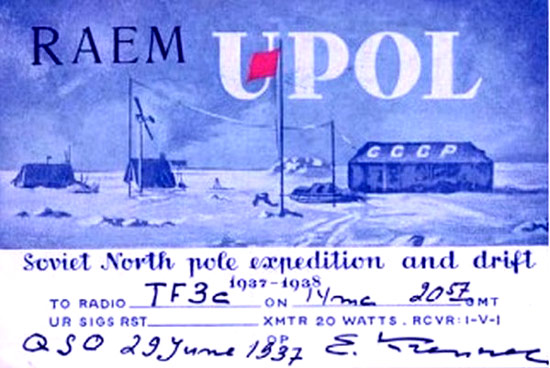

RAEM UPOL 1937 Arctic, European Russia
RADIO STATION AT THE POLE
A conversation with the radio operator of the North Pole polar station E.T. Krenkel
We placed before the designers of the radio laboratory of the People's Commissariat for Internal Affairs the following basic requirements: a total autonomous (i.e. capable of existing independently) portable radio transmitter, durable, with reciprocal back-up and maximum lightness.
A radio station which I will have to operate at the North Pole, built by the Leningrad laboratory especially for our expedition.
V.L. Dobrozhansky, head of the research part of the laboratory who had been involved with the construction of the radio relay centre on Dikson Island, took upon himself leadership in the planning of the radio station. Taking on the work was radio technician N.N. Stromilov, a participant of Arctic sailings, who built two transmitters of 20 and 80 watts power which operated on short and long wave. The working out of two receivers to this transmitter was carried out by chief radio technician A.I. Kovalyov who used original working apparatus which with extraordinary portability allows coverage of a range of waves from 20 to 20,000 m.
The third set of radio equipment is a reserve backup receiving-transmitting radio station created under the direction of senior technician of the ORL comrade Gaukhman who set up the receiving-transmitting radio station on a fixed wave of 600m.
The technicians excellently fulfilled the radio station and adapted to any working conditions.
The main radio station works on long and short wave. For work on short wave range the transmitter is constructed with a three-cascade circuit.
The power of the transmitter is 80 watts with the possibility of reducing to 20 watts. It works solely by wireless telegraphy and I consider such communications most advantageous over long distances. Valves UB-132, SK-164 and GD-50 are used in the transmitter.
The portable wireless transmitter is set into a common framework and gives the means to transmit in the following ranges:
20.5 - 32.5 m 550 - 1600 m
32 - 52.5 m 1800 - 3820 m
50 - 85 m 3200 - 8500 m
230 - 650 m 7500 - 19800 m
The radio is constructed according to 1-V-1 layout with a pentode in the output and with feed-back. UB-152, CB-154 and SB-155 valves are fitted in it.
An additional station power 20 watts "analogous basic".
We also took a reserve station of 20 watts working in the 550-610 m ranges.
During work on long waves the transmitter will feed from a RM-2 transformer.
During our work on short waves we will set working a petrol engine with RM-1 machine.
Besides this we will have 2 complete sets of alkaline accumulators. We will charge the accumulators from a special 200 watts output turbine. During calm weather charging can also be produced from the RM-1 machine coupled with a petrol engine.
Our reserve source of power supply are 3 dry anode batteries and one RUN-10 machine for feeding the anodes. We also have two spare RM-2 and one spare RM-1.
We will construct a one-radial antenna and will extend it on two masts. The height of each mast is 8.5 m and the total length of the antenna 70 m.
It is difficult to say what the communication conditions will be on the drifting ice. Obviously we will work with Rudolph Island on long wave and with coastal stations and Dikson Island on short.
(Conversation with comrade Krenkel made the day before flying away)
Read the Ernst Krenkel RAEM Story by RW3GA!
QSL courtesy of UY5XE
Story courtesy of G4AYO
Ernst Krenkel Story by RW3GA, courtesy of G3ZPF